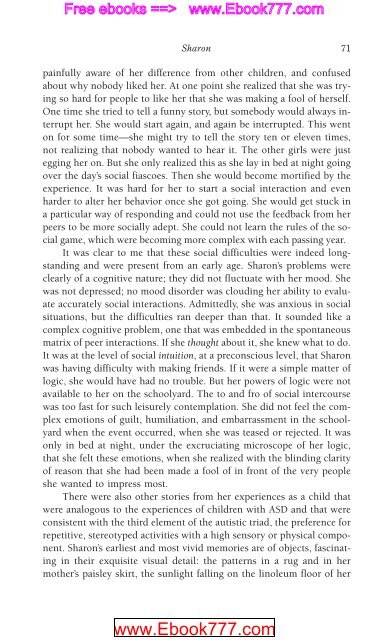978-1572305441
autism
autism
You also want an ePaper? Increase the reach of your titles
YUMPU automatically turns print PDFs into web optimized ePapers that Google loves.
Free ebooks ==> www.Ebook777.com<br />
www.Ebook777.com<br />
Sharon 71<br />
painfully aware of her difference from other children, and confused<br />
about why nobody liked her. At one point she realized that she was trying<br />
so hard for people to like her that she was making a fool of herself.<br />
One time she tried to tell a funny story, but somebody would always interrupt<br />
her. She would start again, and again be interrupted. This went<br />
on for some time—she might try to tell the story ten or eleven times,<br />
not realizing that nobody wanted to hear it. The other girls were just<br />
egging her on. But she only realized this as she lay in bed at night going<br />
over the day’s social fiascoes. Then she would become mortified by the<br />
experience. It was hard for her to start a social interaction and even<br />
harder to alter her behavior once she got going. She would get stuck in<br />
a particular way of responding and could not use the feedback from her<br />
peers to be more socially adept. She could not learn the rules of the social<br />
game, which were becoming more complex with each passing year.<br />
It was clear to me that these social difficulties were indeed longstanding<br />
and were present from an early age. Sharon’s problems were<br />
clearly of a cognitive nature; they did not fluctuate with her mood. She<br />
was not depressed; no mood disorder was clouding her ability to evaluate<br />
accurately social interactions. Admittedly, she was anxious in social<br />
situations, but the difficulties ran deeper than that. It sounded like a<br />
complex cognitive problem, one that was embedded in the spontaneous<br />
matrix of peer interactions. If she thought about it, she knew what to do.<br />
It was at the level of social intuition, at a preconscious level, that Sharon<br />
was having difficulty with making friends. If it were a simple matter of<br />
logic, she would have had no trouble. But her powers of logic were not<br />
available to her on the schoolyard. The to and fro of social intercourse<br />
was too fast for such leisurely contemplation. She did not feel the complex<br />
emotions of guilt, humiliation, and embarrassment in the schoolyard<br />
when the event occurred, when she was teased or rejected. It was<br />
only in bed at night, under the excruciating microscope of her logic,<br />
that she felt these emotions, when she realized with the blinding clarity<br />
of reason that she had been made a fool of in front of the very people<br />
she wanted to impress most.<br />
There were also other stories from her experiences as a child that<br />
were analogous to the experiences of children with ASD and that were<br />
consistent with the third element of the autistic triad, the preference for<br />
repetitive, stereotyped activities with a high sensory or physical component.<br />
Sharon’s earliest and most vivid memories are of objects, fascinating<br />
in their exquisite visual detail: the patterns in a rug and in her<br />
mother’s paisley skirt, the sunlight falling on the linoleum floor of her



